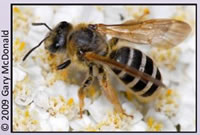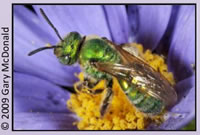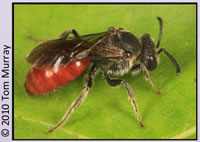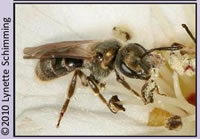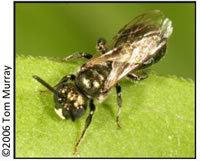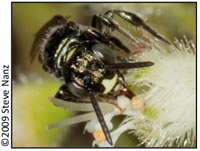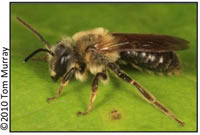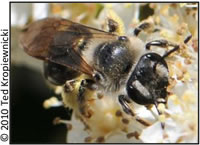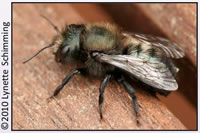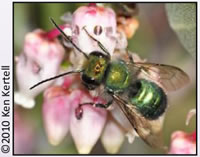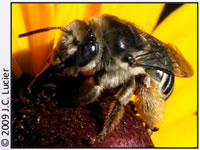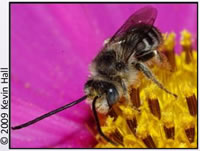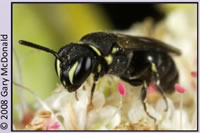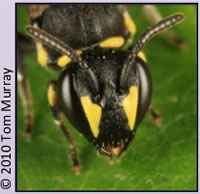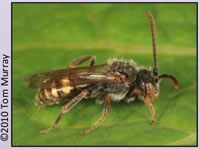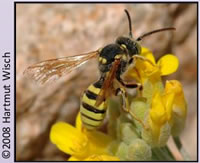Montana Bee Identification Guide
Bees play an important role in natural and agricultural systems as pollinators of flowering plants that provide food, fiber, animal forage, and ecological services like soil and water conservation. In fact, approximately three-quarters of all flowering plants rely on pollinators to reproduce. In addition to honey bees, native bees provide valuable pollination services. Though unknown, the number of native bee species in Montana is likely in the hundreds.
This guide provides information for identifying 10 types of bees commonly found in Montana including descriptions of key characters, size (mm), nesting habitat, and other identifying behaviors.
Contents
Bee Identification
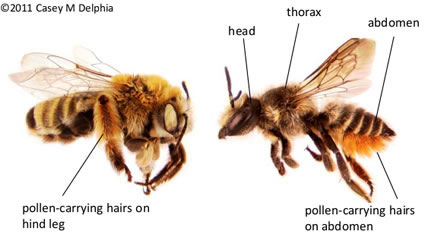
Bees, like other insects, have three body segments: a head, thorax, and abdomen. The head consists of compound eyes, antennae that are segmented and bent, mouthparts that include jaws for chewing, and a tongue for drinking nectar. The thorax bears the legs and four wings (two forewings and two hind-wings). The abdomen contains the sting in female bees. Female bees also have special pollen-carrying hairs or other structures commonly found on the hind legs or the underside of the abdomen. For example, honey bees carry pollen in a pollen basket which is an area on the hind leg that is bare and surrounded by incurving hairs.
A Bee or Not a Bee?
There are two major groups of insects that are commonly confused with bees—flies and wasps. In fact, many flower-visiting flies are actuallybee mimics. By mimicking bees in appearance, they are able to gain protection from predators and even act as bee parasites. So how do you tell them all apart?

Fly Identification
Flies have only two wings, while bees have four. Flies have short, stubby antennae with long hairs or feathery antennae and sucking or sponging mouthparts. Many flies have large eyes that almost meet at the top of their heads.

Wasp Identification
Similar to bees, wasps have four wings, chewing mouthparts, a sting, and long antennae. But, while bees are usually very hairy, wasps are usually smooth and almost hairless. Wasps also have a typical, slender “wasp waist” and rarely have pollen-carrying hairs because most are carnivores and don’t eat pollen. Wasps are important predators of many pest insects including cutworms, aphids, and grasshoppers. Additionally, some wasps make paper nests in trees or on buildings.
Now that you know the difference between bees, wasps, and flies, try the ID quiz (page bottom).
Honey bees (Apis mellifera)
Family: Apidae
Heart-shaped head; hairy eyes; black to amber-brown body with pale and dark stripes on abdomen; barrel-shaped abdomen; pollen basket on hind legs; 10-15mm.
- Social colonies; live in man-made hives and natural cavities like tree holes; swarm to locate new nests
- Honey bees are managed for crop pollination and honey production
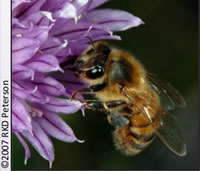
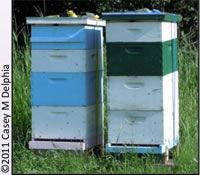
Leafcutting bees (Megachile spp.)
Family: Megachilidae
Head as broad as thorax; large jaws used to cut leaves; black body with pale hair bands on abdomen; pollen-carrying hairs on the underside of abdomen; 7-15 mm.
- Solitary; nest in natural or man-made holes such as beetle tunnels or wood nesting blocks
- Females cut circular pieces from leaves and use them to line their nests
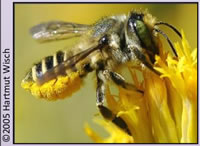
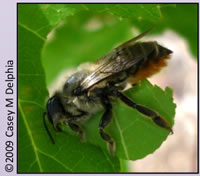
Bumble bees (Bombus spp.)
Family: Apidae
Robust, hairy bees; black body covered with black, yellow, orange, or white hairs in bands; pollen basket on hind legs; 10-23 mm.
- Social colonies; often nest underground in small cavities like old rodent burrows
- Bumble bees can buzz-pollinate, which is important for plants that require vibration to release pollen
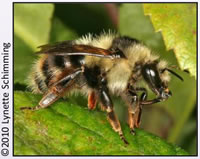
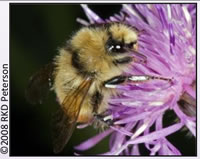
Honey bees (Apis mellifera)
Family: Apidae
Heart-shaped head; hairy eyes; black to amber-brown body with pale and dark stripes on abdomen; barrel-shaped abdomen; pollen basket on hind legs; 10-15mm.
- Social colonies; live in man-made hives and natural cavities like tree holes; swarm to locate new nests
- Honey bees are managed for crop pollination and honey production


|
Leafcutting bees (Megachile spp.)Family: Megachilidae Head as broad as thorax; large jaws used to cut leaves; black body with pale hair bands on abdomen; pollen-carrying hairs on the underside of abdomen; 7-15 mm.
|
|
|
Bumble bees (Bombus spp.)Family: Apidae Robust, hairy bees; black body covered with black, yellow, orange, or white hairs in bands; pollen basket on hind legs; 10-23 mm.
|
|
Sweat beesFamily: Halictidae Many forms including: dull black/brown body with light abdominal hair bands, bright metallic green, dull metallic blue, copper, or green, and black with a red abdomen (parasites of other bees); pollen-carrying hairs on hind legs (except in parasitic bees); 3-11mm.
|
|
|
|
Small carpenter bees (Ceratina spp.)Family: Apidae Shiny, dark metallic blue-green body; sparsely haired; distinctive cylindrical abdomen; pollen-carrying hairs on hind legs; 3-10mm.
|
|
|
Mining bees (Andrena spp.)Family: Andrenidae Black or dull metallic blue or green body; fairly hairy; pollen-carrying hairs on upper parts of hind legs (resemble “armpits”); 6-15 mm.
|
|
|
Mason bees (Osmia spp.)Family: MegachilidaeRobust body; broad, round head and abdomen; usually metallic green or blue; pollen-carrying hairs on underside of abdomen; 5-20 mm.
|
|
|
Long horned bees (Melissodes spp.)Family: ApidaeRobust; hairy; black body with pale hair bands on abdomen; dense pollen-carrying hairs on hind legs; males have very long antennae; 7-16 mm.
|
|
|
Yellow-faced or masked bees (Hylaeus spp.)Family: ColletidaeSlender; almost hairless; black body with yellow or white markings on head, thorax and legs; no pollen-carrying hairs; 5-7 mm.
|
|
|
Cuckoo bees (Nomada spp.)Family: ApidaeWasp-like; sparse branched hairs; red or black body with yellow or white markings; relatively thick antennae; no pollen-carrying hairs; 5-15 mm.
|
|
Bee, Wasp, Fly Identification Quiz
Try to ID each insect based on its visible traits. Answers below.
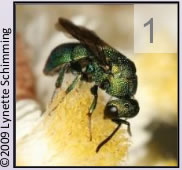 |
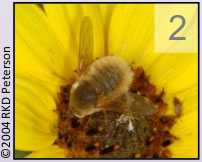 |
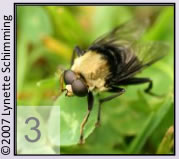 |
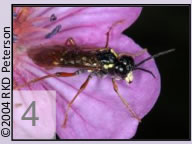 |
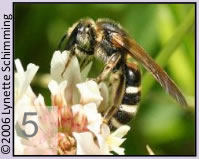 |
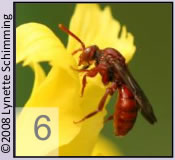 |
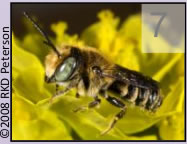 |
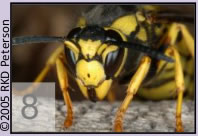 |
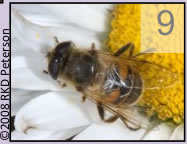 |
Answers:
| 1) Wasp | 2) Fly | 3) Fly |
| 4) Wasp | 5) Sweat bee | 6) Cuckoo bee |
| 7) Leaf cutting bee | 8) Wasp | 9) Fly |
AuthorsCasey M. Delphia, Kevin M. O’Neill |
|
This July 2011 fact sheet is also available as a printable PDF (1.2MB)
Acknowledgements
Thank you to Genna Boland for assistance with AutoMontage® photographs and image editing.

